Sedimentary Characteristics and Genetic Mechanisms of Non-Evaporitic Gypsum in a Half-Graben Basin: A Case Study from the Zhanhua Sag, Bohai Bay Basin, China
Abstract
1. Introduction
2. Geological Setting
3. Materials and Methods
3.1. Thin-Section
3.2. Sulfur Isotope Measurement
3.3. Strontium Isotope Measurement
3.4. Oxygen Isotope Measurement
3.5. Palynological Characteristics
4. Results
4.1. Petrology Characteristics
4.2. Elemental Geochemical Analysis
4.2.1. Sulfur Isotope
4.2.2. Strontium Isotope
4.2.3. Oxygen Isotope
4.3. Organic Geochemical Characteristics
5. Discussion
5.1. Controlling Factors of Gypsum Deposition
5.1.1. Climate
5.1.2. Salinity Stratification
5.1.3. Deep Fault System
5.1.4. Hot Brine
5.2. Model of Gypsum Deposition
5.3. Geological Significance of Unconventional Oil and Gas
6. Conclusions
- (1)
- The deposition of gypsum in the Es4U of Zhanhua Sag is dominated by gypsum and gypsum–mudstone, with some gypsum–limestone and gypsum–dolomite. The cumulative thickness of the gypsum-containing section reaches a maximum of over 110 m. The zone with maximum gypsum deposition thickness shows a high coincidence with the spatial distribution of deep faults. Furthermore, the gypsum is more developed and purer in the center of the Zhanhua Sag. It is interbedded with dark mudstone in the vertical direction, showing the characteristic of alternate deposition.
- (2)
- Microscopic observation identifies the main minerals associated with deep thermohaline activity, such as anhydrite, barite, and authigenic quartz. The production and crystallization structures of the gypsum crystals indicate that the gypsum is not evaporated but is a typical hydrothermal product. The layers that developed the gypsum are extensively fractured, and the gypsum minerals on both sides are not produced simultaneously. Gypsum and mudstone intruded into each other and developed a large number of soft-sediment deformation structures, such as load cast and flame structures. This confirms that gypsum precipitation occurred while underlying mudstone was still unlithified, with hydrothermal fluids interacting with recently deposited mudstone. The mineral composition and developmental characteristics of the gypsum, the contact relationship between gypsum and mudstone, and the depositional sequence reflect the process of intermittent gypsum deposition induced by the pulsed rise in deep thermal brines.
- (3)
- The strontium isotope ratio (87Sr/86Sr) and other inorganic geochemical data are closely similar to that of the same period of deep-source hydrothermal fluids, indicating that the gypsum was precipitated in situ by the mixing of hot brine intrusion and that the saline materials in this period mainly came from deep hot brine. The isotope fractionation was exacerbated by the strong reduction in microorganisms in the deep-water environment. The mechanism of deep-lake gypsum deposition that establishes thermal brine genesis is summarized as follows: the source of gypsum-forming ions is deep thermal brine, and the deep fault system provides a transportation channel. The hot brine activity in the lake and the tectonic shelf are the main factors that control the depositional location and the spreading pattern of gypsum. The density stratification of the lake basin water body causes the deposition to show obvious zoning.
- (4)
- Organic geochemical data suggest that the deep-lake gypsum system has superior hydrocarbon potential. The stable layered brine structure provides anoxic and strong reducing conditions in the bottom water body, and the gypsum cover facilitates the preservation and evolution of organic matter. It is summarized that the genetic model of gypsum formation is based on the rise in deep hot brine, in which gypsum and hydrocarbon source rock are closely symbiotic. It could be a self-generation and self-storage model and has great potential to become the focus of shale oil exploration and development.
- (5)
- This study carries broad scientific and industrial implications. Scientifically, it establishes a hydrothermal genesis model for non-evaporitic gypsum in half-graben basins and provides a new framework for interpreting gypsum–mudstone systems globally. For the exploration of oil and gas, it identifies gypsum–mudstone interlayers as promising shale oil targets, with high TOC (up to 3.15 wt%) and hydrocarbon potential. The proposed self-generation and self-storage model, where gypsum acts as a seal and preserves organic matter, offers novel exploration strategies for basins in China and analogous global settings. This work also integrates isotopic and sedimentological methods for basin-scale resource evaluation, guiding the exploration of unconventional hydrocarbons worldwide.
Author Contributions
Funding
Data Availability Statement
Acknowledgments
Conflicts of Interest
References
- Warren, J.K. Evaporites through time: Tectonic, climatic and eustatic controls in marine and nonmarine deposits. Earth-Sci. Rev. 2010, 98, 217–268. [Google Scholar] [CrossRef]
- Bouroullec, R.; Weimer, P.; Serrano, O. Petroleum Geology of the Mississippi Canyon, Atwater Valley, western DeSoto Canyon, and western Lloyd Ridge protraction areas, northern deep-water Gulf of Mexico: Traps, reservoirs, and tectono-stratigraphic evolution. AAPG Bull. 2017, 101, 1073–1108. [Google Scholar] [CrossRef]
- Hasan, M.N.; Pepper, A.; Mann, P. Basin-scale estimates of thermal stress and expelled petroleum from Mesozoic-Cenozoic potential source rocks, southern Gulf of Mexico. Mar. Pet. Geol. 2023, 148, 105995. [Google Scholar] [CrossRef]
- Wu, Z.; Yin, H.; Wang, X.; Zhao, B.; Zheng, J.; Wang, X.; Wang, W. The structural styles and formation mechanism of salt structures in the southern precaspian basin: Insights from seismic data and analog modeling. Mar. Pet. Geol. 2015, 62, 58–76. [Google Scholar] [CrossRef]
- Jackson, C.A.L.; Duffy, O.B.; Fernandez, N.; Dooley, T.P.; Hudec, M.R.; Jackson, M.P.A.; Burg, G. The Stratigraphic Record of Minibasin Subsidence, Precaspian Basin, Kazakhstan. Basin Res. 2020, 32, 739–763. [Google Scholar] [CrossRef]
- Iadanza, A.; Sampalmieri, G.; Cipollari, P. Deep-seated hydrocarbons in the seep “Brecciated Limestones” of the Maiella area (Adriatic foreland basin): Evaporitic sealing and oil re-mobilization effects linked to the drawdown of the Messinian Salinity Crisis. Mar. Pet. Geol. 2015, 66, 177–191. [Google Scholar] [CrossRef]
- Yi, S.; Li, M.; Guo, X.; Yang, F.; Miao, W.; Lin, S.; Gao, Y. Breakthrough direction of Cambrian pre-salt exploration fields in Tarim basin. Acta Petrol. Sin. 2019, 40, 1281–1295. [Google Scholar]
- Zhuo, X.; Zheng, X.; Chen, X.; Xu, T.; Cui, J. Forming conditions and indicators for deep-water evaporite deposits in inland lake basins: A case study of the Dongpu Sag and modern salt lakes. Earth Sci. Front. 2021, 28, 43–59. [Google Scholar]
- Wittig, C.; Argentino, C.; Panieri, G. Formation of non-evaporitic gypsum in gas hydrate-bearing sediments at Håkon Mosby mud volcano, SW Barents sea. Mar. Pet. Geol. 2024, 165, 106875. [Google Scholar] [CrossRef]
- Smith, M.E.; Carroll, A.R.; Singer, B.S. Synoptic reconstruction of a major ancient lake system: Eocene Green River Formation, western United States. Geol. Soc. Am. Bull. 2008, 120, 54–84. [Google Scholar] [CrossRef]
- Buck, B.J.; Van Hoesen, J.G. Assessing the applicability of isotopic analysis of pedogenic gypsum as a paleoclimate indicator, Southern New Mexico. J. Arid. Environ. 2005, 60, 99–114. [Google Scholar] [CrossRef]
- Gázquez, F.; Morellón, M.; Bauska, T.; Herwartz, D.; Surma, J.; Moreno, A.; Staubwasser, M.; Valero-Garcés, B.; Delgado-Huertas, A.; Hodell, D.A. Triple oxygen and hydrogen isotopes of gypsum hydration water for quantitative paleo-humidity reconstruction. Earth Planet. Sci. Lett. 2018, 481, 177–188. [Google Scholar] [CrossRef]
- Bishop, J.L.; Yeşilbaş, M.; Hinman, N.W.; Burton, Z.F.M.; Englert, P.A.J.; Toner, J.D.; McEwen, A.S.; Gulick, V.C.; Gibson, E.K.; Koeberl, C. Martian subsurface cryosalt expansion and collapse as trigger for landslides. Sci. Adv. 2021, 7, eabe4459. [Google Scholar] [CrossRef]
- Burton, Z.F.M.; Dafov, L.N. Salt diapir-driven recycling of gas hydrate. Geochem. Geophys. Geosyst. 2023, 24, e2022GC010704. [Google Scholar] [CrossRef]
- Vaniman, D.; Chipera, S.; Rampe, E.; Bristow, T.; Blake, D.; Meusburger, J.; Peretyazhko, T.; Rapin, W.; Berger, J.; Ming, D.; et al. Gypsum on Mars: A detailed view at Gale Crater. Minerals 2024, 14, 815. [Google Scholar] [CrossRef]
- Dafov, L.N.; Burton, Z.F.M.; Haines, S.S.; Hosford Scheirer, A.; Masurek, N.; Boswell, R.; Frye, M.; Seol, Y.; Graham, S.A. Terrebonne Basin, Gulf of Mexico gas hydrate resource evaluation and 3-D modeling of basin-scale sedimentation, salt tectonics, and hydrate system evolution since the early Miocene. Mar. Pet. Geol. 2025, 176, 107330. [Google Scholar] [CrossRef]
- Carmeille, M.; Bourillot, R.; Brunet, M.F.; Pellenard, P.; Fürsich, F.T.; Schnyder, J.; Barrier, E.; Blanpied, C.; Sidorova, I. Architecture and sedimentary evolution of the southwestern Gissar carbonate platform (Uzbekistan) during the Middle—Late Jurassic. Mar. Pet. Geol. 2018, 97, 437–465. [Google Scholar] [CrossRef]
- Borrelli, M.; Perri, E.; Critelli, S.; Gindre-Chanu, L. The onset of the Messinian Salinity Crisis in the central Mediterranean recorded by pre-salt carbonate/evaporite deposition. Sedimentology 2021, 68, 1159–1197. [Google Scholar] [CrossRef]
- Morad, S.; Farooq, U.; Mansurbeg, H.; Alsuwaidi, M.; Morad, D.; Al-Aasm, I.; Shahrokhi, S.; Hozayen, M.; Koyi, H. Variations in extent, distribution and impact of dolomitization on reservoir quality of Upper Cretaceous foreland-basin carbonates, Abu Dhabi, United Arab Emirates. Mar. Pet. Geol. 2023, 155, 106357. [Google Scholar] [CrossRef]
- Driussi, O.; Maillard, A.; Ochoa, D.; Lofi, J.; Chanier, F.; Gaullier, V.; Briais, A.; Sage, F.; Sierro, F.; Garcia, M. Messinian Salinity Crisis deposits widespread over the Balearic Promontory: Insights from new high-resolution seismic data. Mar. Pet. Geol. 2015, 66, 41–54. [Google Scholar] [CrossRef]
- Chen, C.; Jiang, Z.; Kong, X.; Wu, S.; Chen, F.; Yang, Y. Sedimentary characteristics of intersalt fine-grained sedimentary rocks and their control on oil-bearing ability of shales in the Qianjiang Formation, Qianjiang Sag. Earth Sci. Front. 2021, 28, 421–435. [Google Scholar]
- Briskin, M.; Schreiber, B.C. Authigenic gypsum in marine sediments. Mar. Geol. 1978, 28, 37–49. [Google Scholar] [CrossRef]
- Bain, R.J. Diagenetic, nonevaporative origin for gypsum. Geology 1990, 18, 447–450. [Google Scholar] [CrossRef]
- Pierre, C. Origin of the authigenic gypsum and pyrite from active methane seeps of the southwest African margin. Chem. Geol. 2017, 449, 158–164. [Google Scholar] [CrossRef]
- Burton, Z.F.M.; Bishop, J.L.; Englert, P.A.J.; Szynkiewicz, A.; Koeberl, C.; Dera, P.; McKenzie, W.; Gibson, E.K. A shallow salt pond analog for aqueous alteration on ancient Mars: Spectroscopy, mineralogy, and geochemistry of sediments from Antarctica’s Dry Valleys. Am. Mineral. 2023, 108, 1017–1031. [Google Scholar] [CrossRef]
- Foerder, A.B.; Englert, P.A.; Bishop, J.L.; Koeberl, C.; Burton, Z.F.; Patel, S.; Gibson, E.K. Don Juan Basin, Antarctica: A chemically altering environment with martian analog potential. Am. Mineral. 2024, 109, 682–700. [Google Scholar] [CrossRef]
- Yoshioka, J.; Kuroda, J.; Matsuzaki, K.M. Cyclostratigraphy of the Miocene Nakayama Formation on Sado Island in central Japan and paleoceanographic implications. Prog. Earth Planet Sci. 2025, 12, 33. [Google Scholar] [CrossRef]
- Liu, X.; Li, A.; Dong, J.; Zhuang, G.; Xu, F.; Wan, S. Nonevaporative origin for gypsum in mud sediments from the East China Sea shelf. Mar. Chem. 2018, 205, 90–97. [Google Scholar] [CrossRef]
- Zhao, J.; Wang, J.; Phillips, S.C.; Liang, J.; Su, P.; Lin, Q.; Chen, C.; Liu, J. Non-evaporitic gypsum formed in marine sediments due to sulfate-methane transition zone fluctuations and mass transport deposits in the northern South China Sea. Mar. Chem. 2021, 233, 103988. [Google Scholar] [CrossRef]
- Meng, T.; Liu, P.; Qiu, L.; Wang, Y.; Liu, Y.; Lin, H.; Cheng, F.; Qu, C. Formation and distribution of the high quality reservoirs in a deep saline lacustrine basin: A case study from the upper part of the 4th member of Paleogene Shahejie Formation in Bonan Sag, Jiyang depression, Bohai Bay Basin, east China. Pet. Explor. Dev. 2017, 44, 948–959. [Google Scholar] [CrossRef]
- Dela Pierre, F.; Clari, P.; Natalicchio, M.; Ferrando, S.; Giustetto, R.; Lozar, F.; Lugli, S.; Manzi, V.; Roveri, M.; Violanti, D. Flocculent layers and bacterial mats in the mudstone interbeds of the Primary Lower Gypsum unit (Tertiary Piedmont basin, NW Italy): Archives of palaeoenvironmental changes during the Messinian salinity crisis. Mar. Geol. 2014, 355, 71–87. [Google Scholar] [CrossRef]
- Andeskie, A.S.; Benison, K.C.; Eichenlaub, L.A.; Raine, R. Acid-saline-lake Systems of the Triassic Mercia Mudstone Group, County Antrim, Northern Ireland. J. Sediment. Res. 2018, 88, 385–398. [Google Scholar] [CrossRef]
- Guo, P.; Li, C. Genesis of evaporites in petroliferous basins and the sedimentary and climatic significances. J. Palaeogeogr. 2022, 24, 210–225. [Google Scholar]
- Ma, C. Study on Characteristics and Effectiveness of Lacustrine Shale Reservoir. Ph.D. Dissertation, China University of Petroleum (East China), Qingdao, China, 2017. [Google Scholar]
- Yang, Y. Study on Lacustrine Carbonate Reservoirs in Shaojia Area. Ph.D. Dissertation, China University of Geosciences (Beijing), Beijing, China, 2020. [Google Scholar]
- Dill, H.G.; Kaufhold, S. The Totumo mud volcano and its near-shore marine sedimentological setting (North Colombia)—From sedimentary volcanism to epithermal mineralization. Sediment. Geol. 2018, 366, 14–31. [Google Scholar] [CrossRef]
- Magoon, L.B.; Dow, W.G. The petroleum system. In The Petroleum System—From Source to Trap: AAPG Memoir 60; Magoon, L.B., Dow, W.G., Eds.; American Association of Petroleum Geologists: Tulsa, OK, USA, 1994; pp. 3–24. [Google Scholar]
- Zhang, J.; Jiang, Z.; Liu, L.; Yuan, F.; Feng, L.; Li, C. Lithofacies and depositional evolution of fine-grained sedimentary rocks in the lower submember of the member 3 of Shahejie Formation in Zhanhua Sag, Bohai Bay Basin. Acta Petrol. Sin. 2021, 42, 293–306. [Google Scholar]
- Tian, R.; Xian, B.; Wu, Q.; Shu, Q.; Liu, J.; Zhang, W.; Wang, Z.; Li, Q.; Rahman, N.U.; Gao, Y.; et al. Turbidite system controlled by fault interaction and linkage on a slope belt of rift basin: Zhanhua depression, Bohai Bay Basin, China. Mar. Pet. Geol. 2023, 155, 106377. [Google Scholar] [CrossRef]
- Lin, C.; Zheng, H.; Ren, J.; Qiu, Y. The control of syndepositional faulting on the Eogene sedimentary basin fills of the Dongying and Zhanhua sags, Bohai Bay Basin. Sci. China Ser. D Earth Sci. 2004, 47, 769–782. [Google Scholar] [CrossRef]
- Shi, J.; Jin, Z.; Liu, Q.; Huang, Z.; Hao, Y. Terrestrial sedimentary responses to astronomically forced climate changes during the early Paleogene in the Bohai Bay basin, eastern China. Palaeogeogr. Palaeoclimatol. Palaeoecol. 2018, 502, 1–12. [Google Scholar] [CrossRef]
- Gupta, D.K.; Deb, U.; Walther, C.; Chatterjee, S. Strontium in the Ecosystem: Transfer in Plants via Root System. In Behaviour of Strontium in Plants and the Environment; Gupta, D.K., Walther, C., Eds.; Springer International Publishing: Berlin/Heidelberg, Germany, 2018; pp. 1–18. [Google Scholar] [CrossRef]
- Baddouh, M.; Meyers, S.R.; Carroll, A.R.; Beard, B.L.; Johnson, C.M. Lacustrine 87Sr/86Sr as a tracer to reconstruct Milankovitch forcing of the Eocene hydrologic cycle. Earth Planet. Sci. Lett. 2016, 448, 62–68. [Google Scholar] [CrossRef]
- Geng, H.; Sun, M.; Yuan, C.; Xiao, W.; Xian, W.; Zhao, G.; Zhang, L.; Wong, K.; Wu, F. Geochemical, Sr–Nd and zircon U–Pb–Hf isotopic studies of Late Carboniferous magmatism in the West Junggar, Xinjiang: Implications for ridge subduction? Chem. Geol. 2009, 266, 364–389. [Google Scholar] [CrossRef]
- Viola, I.; Capozzi, R.; Bernasconi, S.M.; Rickli, J. Carbon, oxygen and strontium isotopic constraints on fluid sources, temperatures and biogeochemical processes during the formation of seep carbonates-Secchia River site, Northern Apennines. Sediment. Geol. 2017, 357, 1–15. [Google Scholar] [CrossRef]
- Brookfield, M.E.; Shellnutt, J.G.; Yui, T.-F. Climatic fluctuations during a mass extinction: Rapid carbon and oxygen isotope variations across the Permian-Triassic (PTr) boundary at Guryul Ravine, Kashmir, India. J. Asian Earth Sci. 2022, 227, 105066. [Google Scholar] [CrossRef]
- Li, Y.; Allen, M.B.; Li, X.H. Millennial pulses of ore formation and an extra-high Tibetan Plateau. Geology 2022, 50, 665–669. [Google Scholar] [CrossRef]
- Birks, H.; Lotter, A.; Juggins, S.; Smol, J. Data handling and numerical techniques. In Tracking Environmental Change Using Lake Sediments; Springer: Dordrecht, The Netherlands, 2012; Volume 5. [Google Scholar] [CrossRef]
- Zhao, Y. Vegetation and climate reconstructions on different time scales in China: A review of Chinese palynological research. Veg. Hist. Archaeobot. 2018, 27, 381–392. [Google Scholar] [CrossRef]
- Wang, J.; Chen, D.; Yan, D. Variation in carbon and sulphur isotopes and environments during the critical geological transitions. Earth Sci. Front. 2009, 16, 33–47. [Google Scholar]
- Wade, B.S.; O’NEill, J.F.; Phujareanchaiwon, C.; Ali, I.; Lyle, M.; Witkowski, J. Evolution of deep-sea sediments across the Paleocene-Eocene and Eocene-Oligocene boundaries. Earth-Sci. Rev. 2020, 211, 103403. [Google Scholar] [CrossRef]
- Pogge von Strandmann, P.A.; Jones, M.T.; West, A.J.; Murphy, M.J.; Stokke, E.W.; Tarbuck, G.; Wilson, D.J.; Pearce, C.R.; Schmidt, D.N. Lithium isotope evidence for enhanced weathering and erosion during the Paleocene-Eocene Thermal Maximum. Sci. Adv. 2021, 7, eabh4224. [Google Scholar] [CrossRef]
- Burton, Z.F.M.; McHargue, T.; Kremer, C.H.; Bloch, R.B.; Gooley, J.T.; Jaikla, C.; Harrington, J.; Graham, S.A. Peak Cenozoic warmth enabled deep-sea sand deposition. Sci. Rep. 2023, 13, 1276. [Google Scholar] [CrossRef]
- Burton, Z.F.M.; McHargue, T.R.; Graham, S.A. Global Eocene-Oligocene unconformity in clastic sedimentary basins. Earth-Sci. Rev. 2024, 258, 104912. [Google Scholar] [CrossRef]
- Bougeois, L.; Dupont-Nivet, G.; de Rafélis, M.; Tindall, J.C.; Proust, J.-N.; Reichart, G.-J.; de Nooijer, L.J.; Guo, Z.; Ormukov, C. Asian monsoons and aridification response to Paleogene sea retreat and Neogene westerly shielding indicated by seasonality in Paratethys oysters. Earth Planet. Sci. Lett. 2018, 485, 99–110. [Google Scholar] [CrossRef]
- Wang, J.; Peng, J.; Cao, Y.; Liu, K.; Song, M.; Liu, H. Mid-late Eocene paleoclimate characteristics and significance in the Dongying depression: An example from well hk-1. Acta Sedimentol. Sin. 2022, 40, 1059–1072. [Google Scholar]
- Liu, P.; Song, G.; Liu, Y.; Meng, T. Mechanism of depositional system in upper fourth member of Shahejie Formation in Bonan Sag. J. Cent. South Univ. 2014, 45, 3234–3243. [Google Scholar]
- Gou, H.; Wei, H.; Duan, R.; Chen, T.; Fan, Q.; Du, Y.; Cao, X. Spatial distribution of modern pollen and fungal spores and their ecological indication in Qinghai Lake on northeastern Tibetan Plateau, China. Ecol. Indic. 2022, 144, 109474. [Google Scholar] [CrossRef]
- Reiss, A.G.; Gavrieli, I.; Rosenberg, Y.O.; Reznik, I.J.; Luttge, A.; Emmanuel, S.; Ganor, J. Gypsum Precipitation under Saline Conditions: Thermodynamics, Kinetics, Morphology, and Size Distribution. Minerals 2021, 11, 141. [Google Scholar] [CrossRef]
- Kraemer, B.M.; Anneville, O.; Chandra, S.; Dix, M.; Kuusisto, E.; Livingstone, D.M.; Rimmer, A.; Schladow, S.G.; Silow, E.; Sitoki, L.M.; et al. Morphometry and average temperature affect lake stratification responses to climate change. Geophys. Res. Lett. 2015, 42, 4981–4988. [Google Scholar] [CrossRef]
- Ladwig, R.; Rock, L.; Dugan, H. Impact of salinization on lake stratification and spring mixing. Limnol. Oceanogr. Lett. 2021, 8, 93–102. [Google Scholar] [CrossRef]
- Woolway, R.I.; Sharma, S.; Weyhenmeyer, G.A.; Debolskiy, A.; Golub, M.; Mercado-Bettin, D.; Perroud, M.; Stepanenko, V.; Tan, Z.; Grant, L.; et al. Phenological shifts in lake stratification under climate change. Nat. Commun. 2021, 12, 2318. [Google Scholar] [CrossRef]
- Peters, K.E.; Walters, C.C.; Moldowan, J.M. The Biomarker Guide: Volume 1: Biomarkers and Isotopes in the Environment and Human History; Cambridge University Press: Cambridge, UK, 2004. [Google Scholar]
- Burton, Z.F.M.; Moldowan, J.M.; Magoon, L.B.; Sykes, R.; Graham, S.A. Interpretation of source rock depositional environment and age from seep oil, east coast of New Zealand. Int. J. Earth Sci. 2019, 108, 1079–1091. [Google Scholar] [CrossRef]
- Song, Y.; Gilleaudeau, G.J.; Algeo, T.J.; Over, D.J.; Lyons, T.W.; Anbar, A.D.; Xie, S. Biomarker evidence of algal-microbial community changes linked to redox and salinity variation, Upper Devonian Chattanooga Shale (Tennessee, USA). Geol. Soc. Am. Bull. 2020, 133, 409–424. [Google Scholar] [CrossRef]
- Amadi, F.O.; Major, R.P.; Baria, L.R. Origins of gypsum in deep carbonate reservoirs: Implications for hydrocarbon exploration and production. AAPG Bull. 2012, 96, 375–390. [Google Scholar] [CrossRef]
- Liu, P. Characteristics and petroleum geological significance of gypsum-salt beds in the upper part of fourth member of Shahejie Formation in Bonan Sag. J. Shengli Coll. China Univ. Petrol. 2019, 33, 10–13. [Google Scholar]
- Faure, G. Origin of Igneous Rocks: The Isotopic Evidence; Springer: Berlin/Heidelberg, Germany, 2001. [Google Scholar] [CrossRef]
- Weber, N.; Antler, G.; Lazar, B.; Stein, M.; Yechieli, Y.; Gavrieli, I. Hydrological and thermodynamic controls on late Holocene gypsum formation by mixing saline groundwater and Dead Sea brine. Geochim. Cosmochim. Acta 2022, 316, 363–383. [Google Scholar] [CrossRef]
- Moneron, J. Major heterogeneity in evaporitic depositional systems: The genesis of kilometre-scale gypsum networks in the Zechstein Basin. Global Planet. Change 2025, 246, 104710. [Google Scholar] [CrossRef]
- Zhang, S.; Zhang, L.; Li, Z.; Hao, Y. Formation conditions of Paleogene shale oil and gas in Jiyang depression. Pet. Geol. Recovery Effic. 2012, 19, 5. [Google Scholar]
- Zhao, Z.; Zhou, Y.; Ma, X.; Ji, G. The impact of saline deposit upon the hydrocarbon accumulation in petroliferous basin. Oil Gas Geol. 2007, 28, 299–308. [Google Scholar]
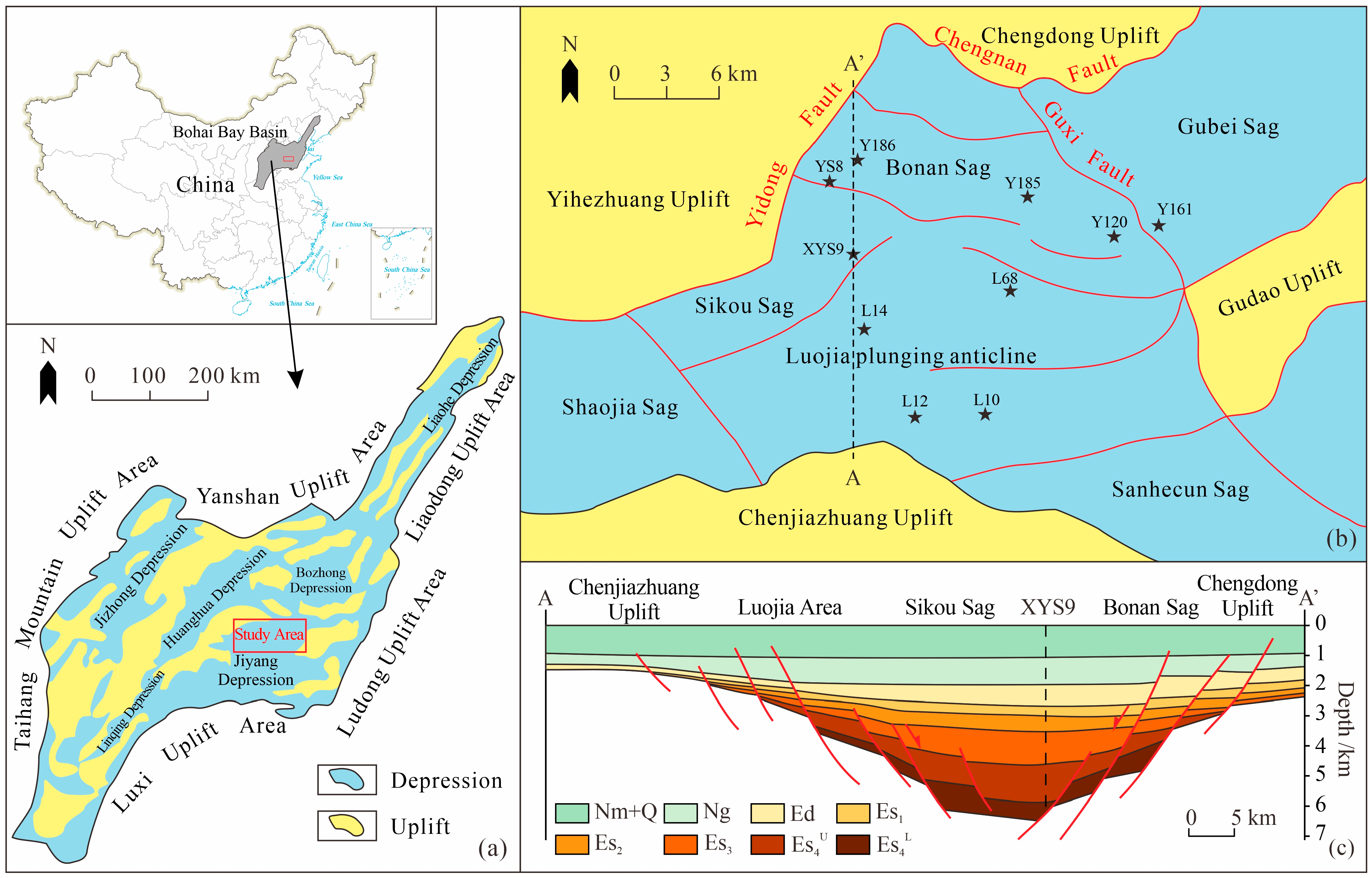
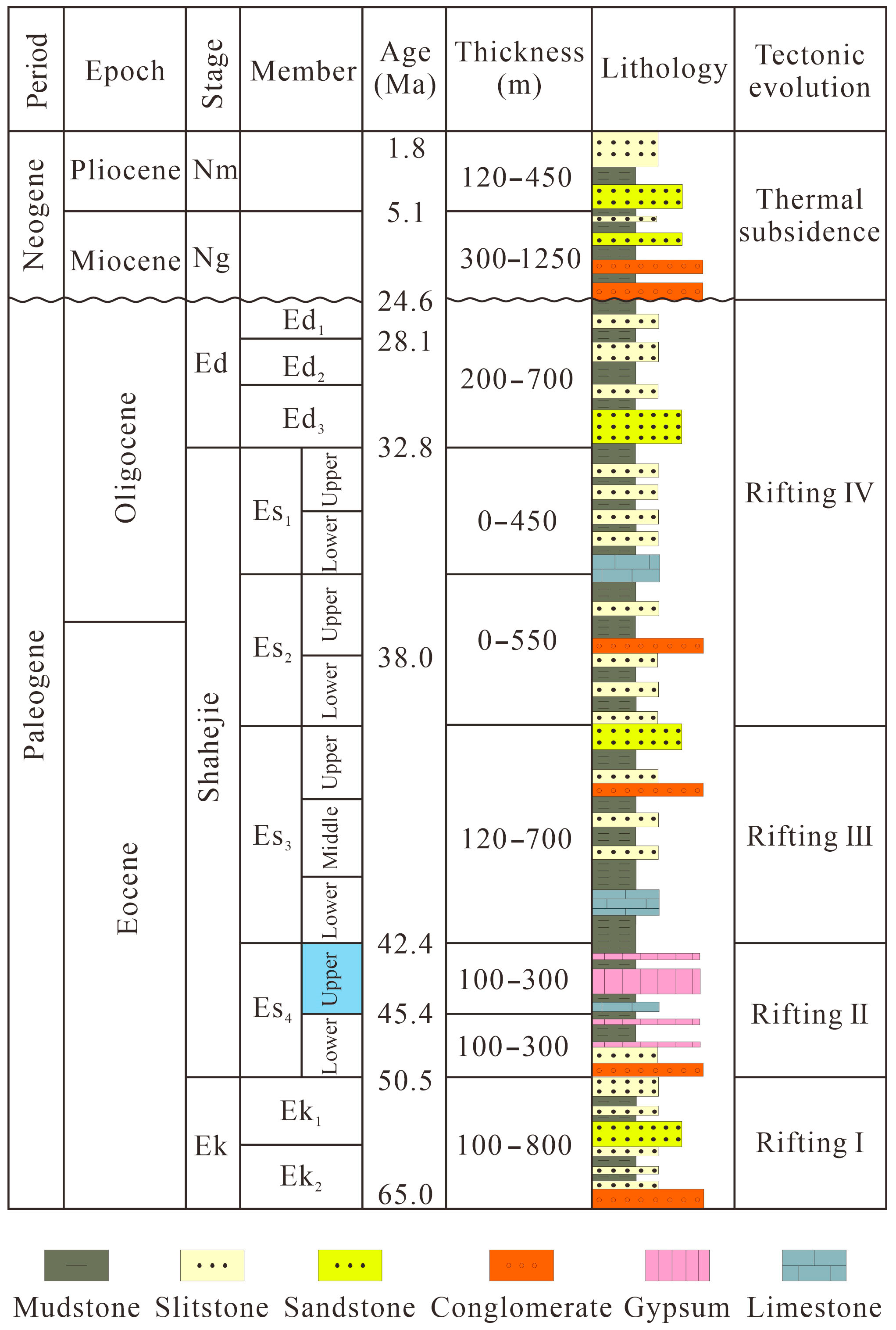
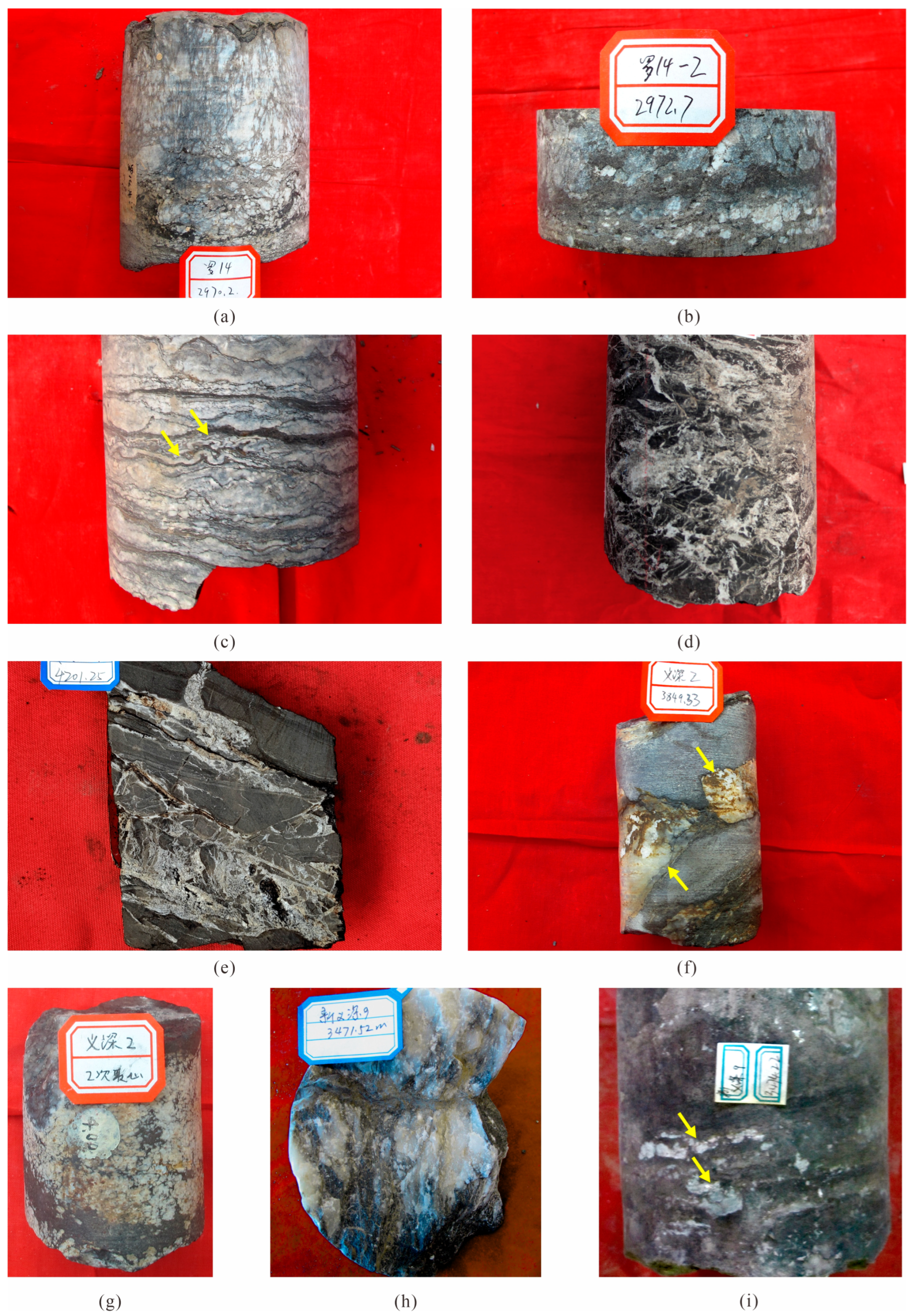

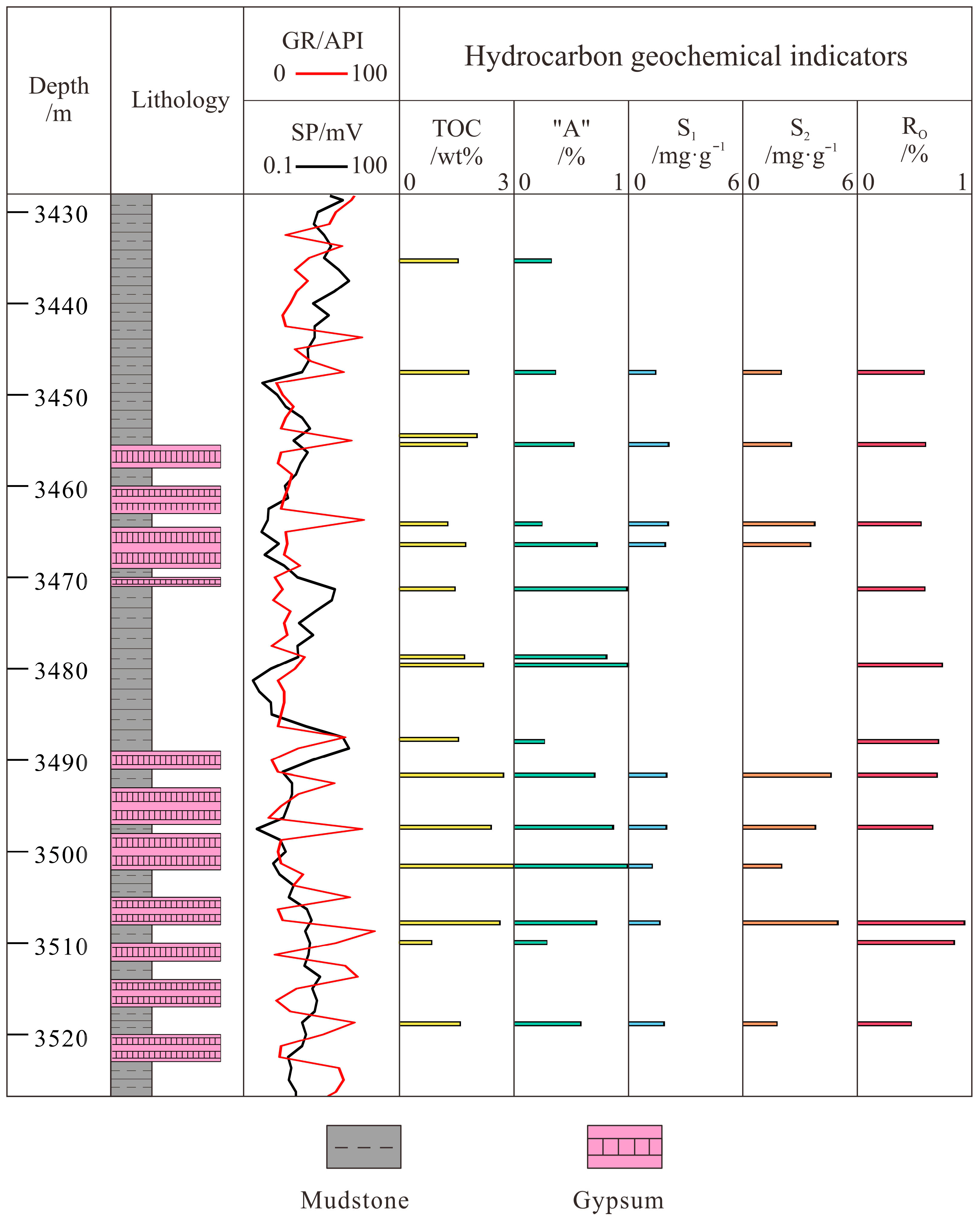
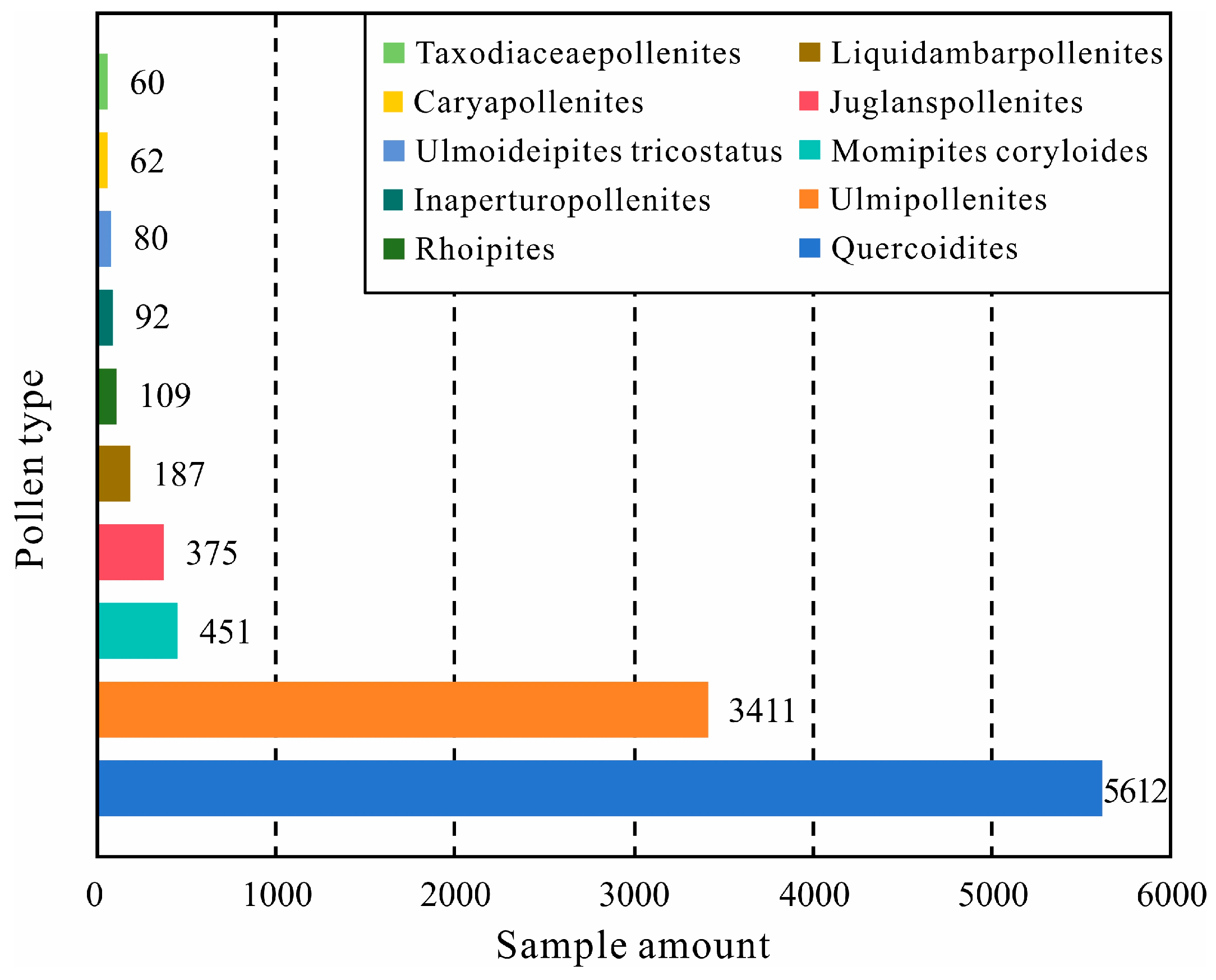
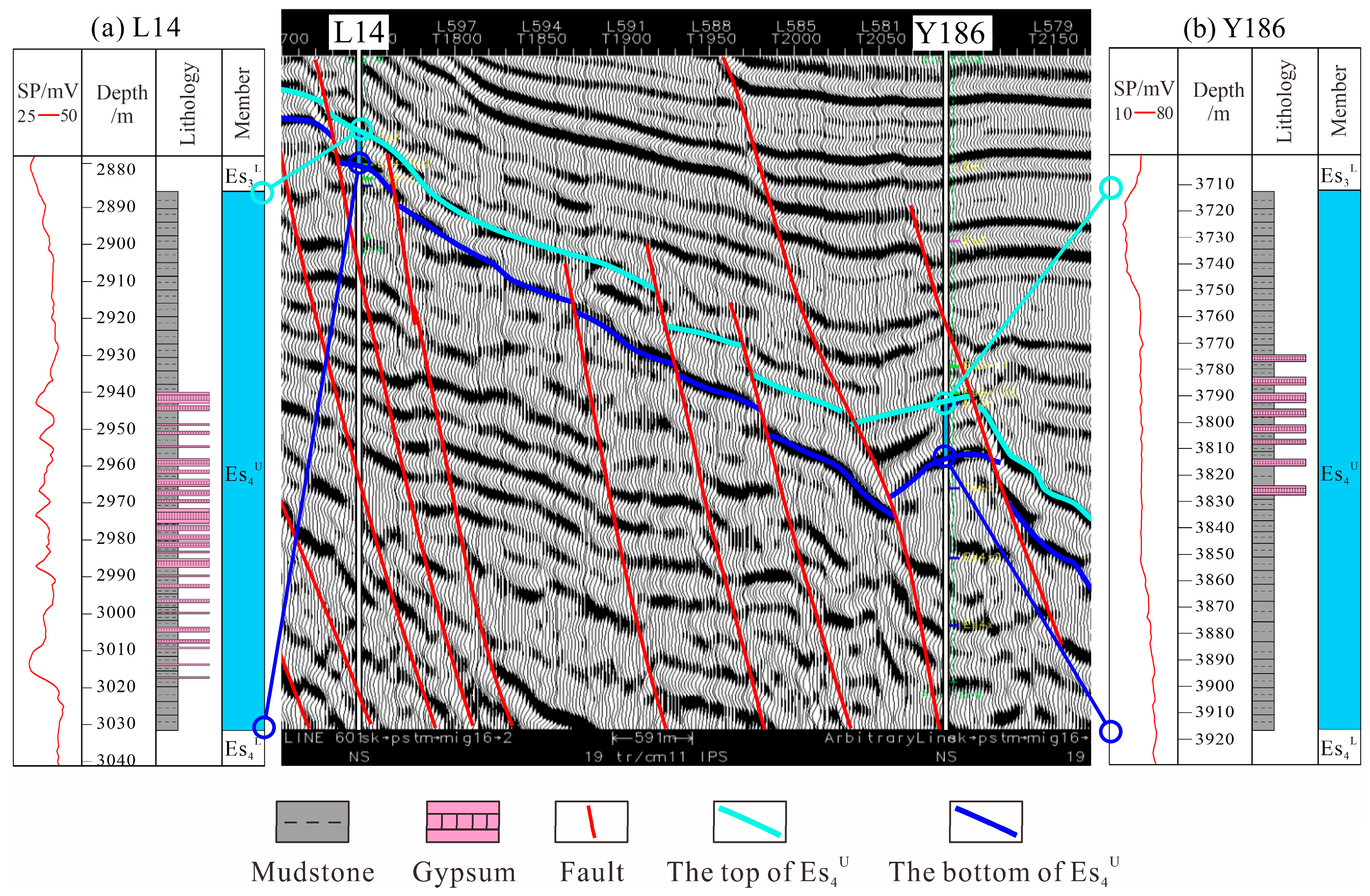
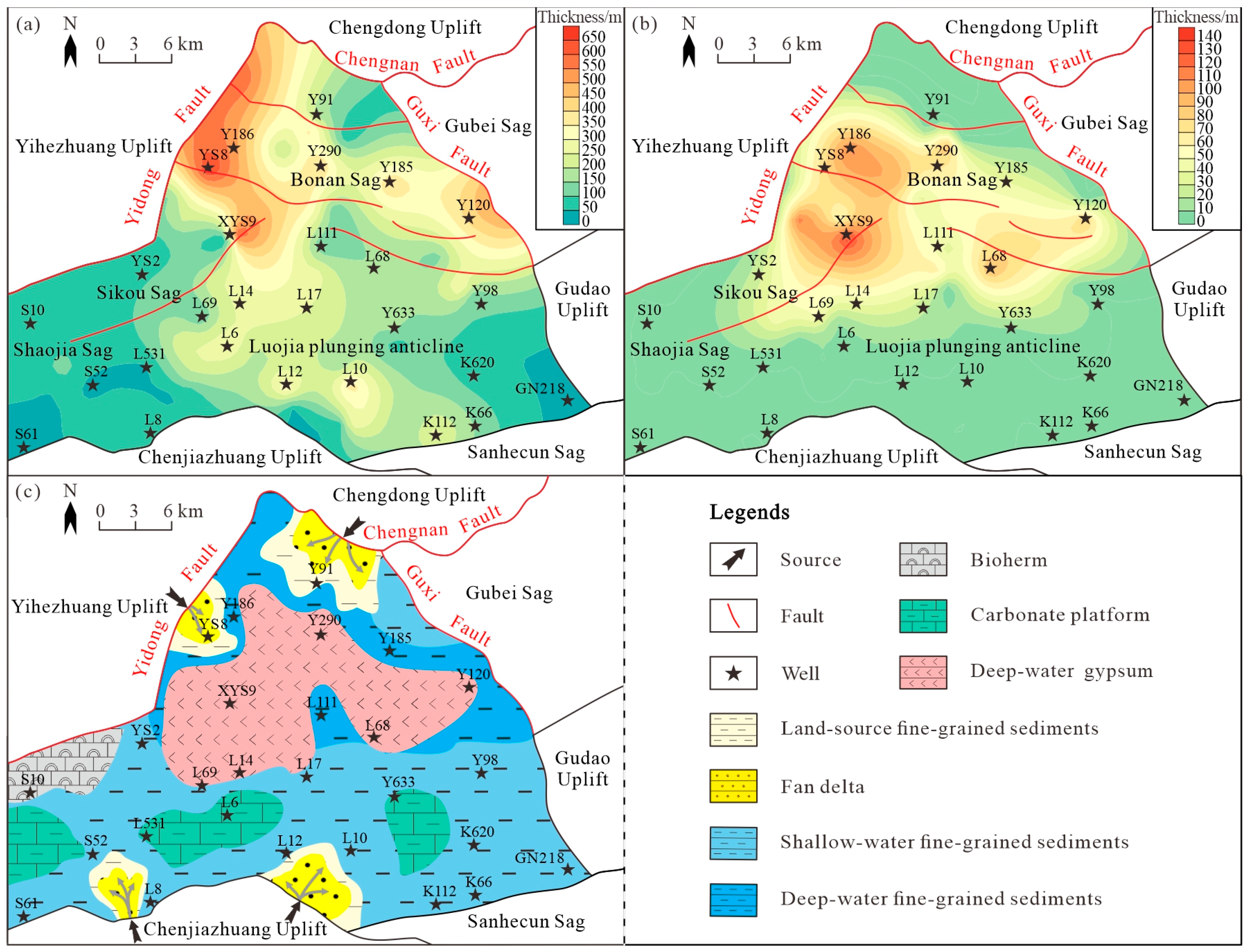
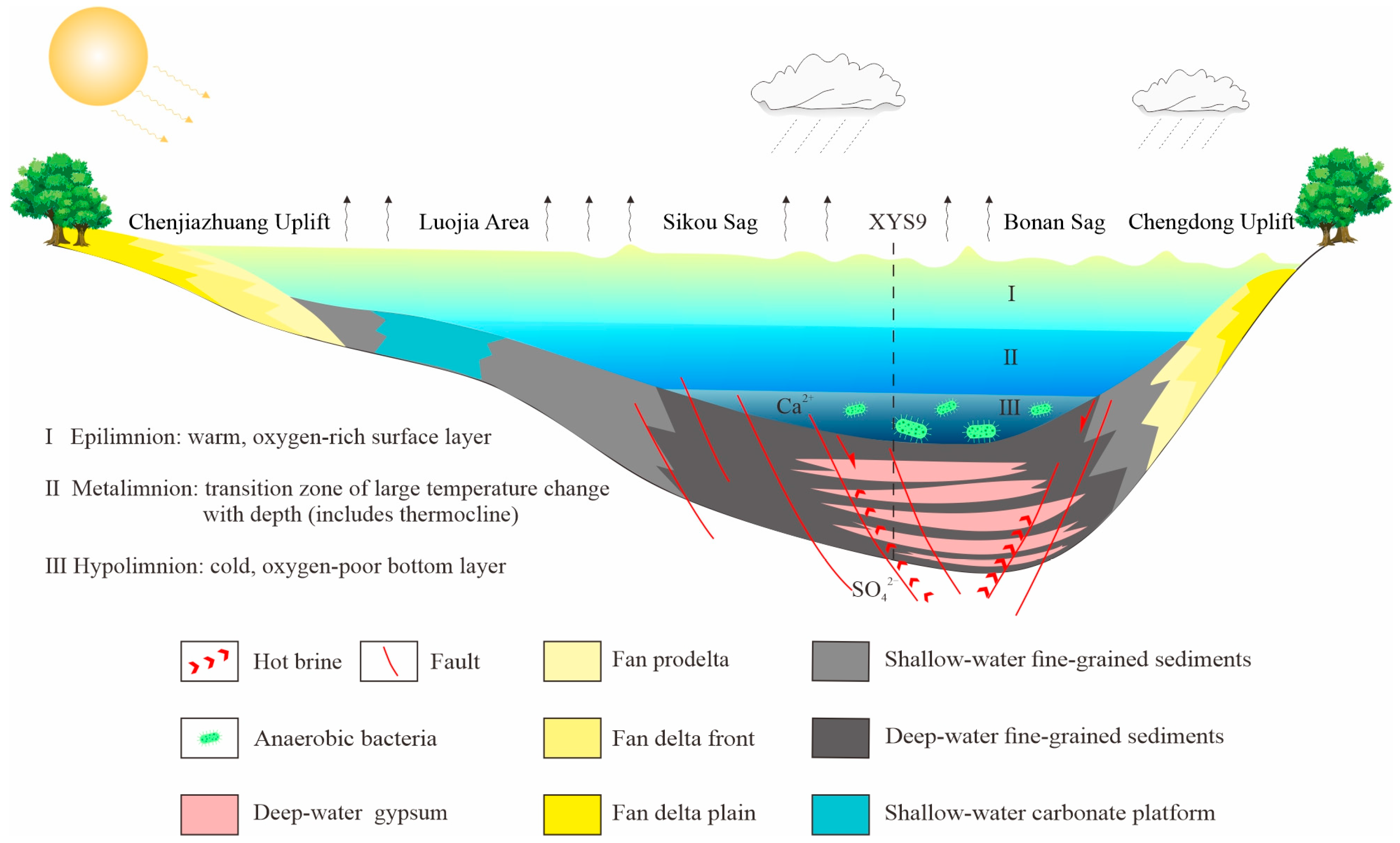
| Well | Depth (m) | Lithology | δ34S (‰) | σ (‰) |
|---|---|---|---|---|
| L14 | 2952.11 | Gypsum | 37.60 | 0.012 |
| L14 | 3000.90 | Gypsum | 37.00 | 0.012 |
| L602 | 2650.51 | Gypsum | 35.10 | 0.012 |
| L602 | 2650.81 | Gypsum | 35.00 | 0.012 |
| Y186 | 4176.64 | Gypsum | 34.70 | 0.012 |
| Y186 | 4177.23 | Gypsum | 37.50 | 0.012 |
| YS6 | 3503.60 | Gypsum | 30.93 | 0.012 |
| YS6 | 3513.90 | Gypsum | 31.00 | 0.012 |
| YS6 | 3523.70 | Gypsum | 30.22 | 0.012 |
| XYS9 | 3470.22 | Gypsum | 35.10 | 0.012 |
| XYS9 | 3471.00 | Gypsum | 35.20 | 0.012 |
| XYS9 | 3473.00 | Gypsum | 35.90 | 0.012 |
| XYS9 | 3473.14 | Gypsum | 34.80 | 0.012 |
| Well | Depth (m) | Lithology | 87Sr/86Sr | Absolute Error (2σ) |
|---|---|---|---|---|
| L14 | 3000.90 | Gypsum | 0.709359 | 0.000012 |
| L14 | 2952.11 | Gypsum | 0.709554 | 0.000014 |
| L602 | 2650.51 | Gypsum | 0.709750 | 0.000018 |
| L602 | 2650.81 | Gypsum | 0.709738 | 0.000016 |
| Y186 | 4176.64 | Gypsum | 0.709152 | 0.000021 |
| Y186 | 4177.23 | Gypsum | 0.709177 | 0.000021 |
| L2 | 3125.50 | Gypsum | 0.709707 | 0.000016 |
| Well | Depth (m) | Lithology | δ18OPDB (‰) |
|---|---|---|---|
| L67 | 3380.5 | Gypseous mudstone | −7 |
| L67 | 3380.95 | Gypseous mudstone | −7.5 |
| L67 | 3382.75 | Gypsum rock | −6.7 |
| L67 | 3448.34 | Gypsum rock | −11.8 |
| L67 | 3448.87 | Gypsum rock | −13.3 |
| L67 | 3450.77 | Gypseous mudstone | −11.9 |
Disclaimer/Publisher’s Note: The statements, opinions and data contained in all publications are solely those of the individual author(s) and contributor(s) and not of MDPI and/or the editor(s). MDPI and/or the editor(s) disclaim responsibility for any injury to people or property resulting from any ideas, methods, instructions or products referred to in the content. |
© 2025 by the authors. Licensee MDPI, Basel, Switzerland. This article is an open access article distributed under the terms and conditions of the Creative Commons Attribution (CC BY) license (https://creativecommons.org/licenses/by/4.0/).
Share and Cite
Cai, M.; Zhang, J.; Jiang, Z.; Li, J.; Meng, T.; Liu, P.; Jiang, C. Sedimentary Characteristics and Genetic Mechanisms of Non-Evaporitic Gypsum in a Half-Graben Basin: A Case Study from the Zhanhua Sag, Bohai Bay Basin, China. J. Mar. Sci. Eng. 2025, 13, 1300. https://doi.org/10.3390/jmse13071300
Cai M, Zhang J, Jiang Z, Li J, Meng T, Liu P, Jiang C. Sedimentary Characteristics and Genetic Mechanisms of Non-Evaporitic Gypsum in a Half-Graben Basin: A Case Study from the Zhanhua Sag, Bohai Bay Basin, China. Journal of Marine Science and Engineering. 2025; 13(7):1300. https://doi.org/10.3390/jmse13071300
Chicago/Turabian StyleCai, Muxin, Jianguo Zhang, Zaixing Jiang, Junliang Li, Tao Meng, Peng Liu, and Chao Jiang. 2025. "Sedimentary Characteristics and Genetic Mechanisms of Non-Evaporitic Gypsum in a Half-Graben Basin: A Case Study from the Zhanhua Sag, Bohai Bay Basin, China" Journal of Marine Science and Engineering 13, no. 7: 1300. https://doi.org/10.3390/jmse13071300
APA StyleCai, M., Zhang, J., Jiang, Z., Li, J., Meng, T., Liu, P., & Jiang, C. (2025). Sedimentary Characteristics and Genetic Mechanisms of Non-Evaporitic Gypsum in a Half-Graben Basin: A Case Study from the Zhanhua Sag, Bohai Bay Basin, China. Journal of Marine Science and Engineering, 13(7), 1300. https://doi.org/10.3390/jmse13071300






